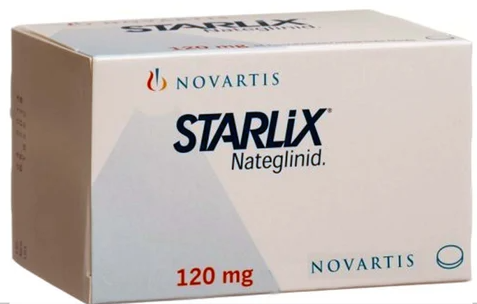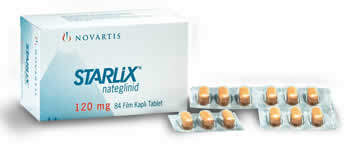Starlix (Nateglinide)











Dosages
Starlix 120 mg
| Quantity | Price per pill | Total price | |
|---|---|---|---|
| 30 | $1.33 | $40.00 | |
| 60 | $1.12 | $67.00 | |
| 90 | $1.04 | $94.00 | |
| 120 | $1.00 | $120.00 | |
| 180 | $0.96 | $173.00 | |
| 270 | $0.90 | $243.00 | |
| 360 | $0.80 | $288.00 |
Payment & Shipping
Your order is securely packed and usually ships within 24 hours. Here's what a typical package looks like.
It is about the size of a regular letter (9.4x4.3x0.3 inches) and shows no details about what is inside.



| Shipping Method | Estimated delivery |
|---|---|
| Express Free for orders over $300.00 | Estimated delivery to the U.S.: 4-7 days |
| Standard Free for orders over $200.00 | Estimated delivery to the U.S.: 14-21 days |









Discount Coupons
- Independence Day - July 4, 2025 10% JULY410
- Labor Day - September 1, 2025 7% LABOR07
- Thanksgiving - November 27, 2025 9% THANKS09
Brand Names
| Country | Brand Names |
|---|---|
 Argentina Argentina | Nateglin |
 Czechia Czechia | Trazec |
 Japan Japan | Starsis |
 Netherlands Netherlands | Trazec |
 Portugal Portugal | Trazec |
| Manufacturer | Brand Names |
|---|---|
| Glenmark Pharmaceuticals Ltd. | Glinate |
FAQ
Description
What Is Starlix (Nateglinide)?
Starlix, or nateglinide, is an oral medication for treating type 2 diabetes. It belongs to the class of drugs known as meglitinides, which stimulate insulin release from the pancreas. Nateglinide targets the beta cells in the pancreas, prompting them to release insulin in response to a meal. This helps control blood sugar levels by facilitating glucose uptake into cells. It is typically taken before meals to manage post-meal spikes in blood sugar. As with any medication, individuals need to follow their healthcare provider's instructions and maintain a healthy lifestyle, including proper diet and exercise, while using Starlix.
NDC Codes: 55111-328-30, 55111-328-90, 55111-328-01, 55111-328-05, 55111-328-78, 55111-329-30, 55111-329-90, 55111-329-01, 55111-329-05, 55111-329-78.

Ingredients
The active ingredient in Starlix (Nateglinide) is nateglinide. As for the inactive ingredients, these can vary depending on the specific formulation and manufacturer. Common inactive pharmaceutical ingredients often include fillers, binders, coloring agents, and coatings. It's always a good idea to check the product packaging or consult a pharmacist for the most accurate and up-to-date information on the specific formulation of Starlix you are using.
Who Can Take Starlix (Nateglinide)
Starlix (Nateglinide) is typically prescribed to individuals with type 2 diabetes. It is intended for adults and is not recommended for those with type 1 diabetes or diabetic ketoacidosis. It may be prescribed alone or in combination with other diabetes medications to help control blood sugar levels. However, individuals must consult their healthcare provider to determine if Starlix is the right choice for them, as medical history, existing health conditions, and other medications being taken can impact its suitability. Pregnant or breastfeeding individuals, as well as those with certain liver or kidney conditions, may need special considerations or alternative treatments. Always follow your healthcare provider's guidance regarding medication use.
Dosage Sizes
The dosage of Starlix (Nateglinide) can vary based on individual factors and the recommendations of a healthcare provider. Generally, it is taken orally before meals to control post-meal spikes in blood sugar levels. Starting doses may range from 60 to 120 milligrams, taken three times daily before meals. However, the specific dosage and frequency can be adjusted based on the individual's response and needs.
It's crucial to adhere to the prescribed dosage and follow the healthcare provider's instructions carefully. Factors such as kidney function, medications taken, and overall health may influence the appropriate dosage. Regular monitoring and communication with a healthcare provider are essential to ensure the medication is effective and well-tolerated.
Important Safety Information
Taking Starlix may increase the risk of hypoglycemia (low blood sugar). It's essential to follow the prescribed dosage and timing of the medication and monitor blood sugar levels regularly.
Individuals with a known allergy to nateglinide or any inactive ingredients in Starlix should avoid taking it. Allergic reactions can be severe, including rash, itching, swelling, severe dizziness, or difficulty breathing.
The liver metabolizes Starlix, so individuals with liver disease or impaired liver function should use it cautiously. Regular monitoring of liver function may be necessary.
Pregnant or breastfeeding individuals should consult their healthcare provider before using Starlix, as its safety in these situations may not be well-established.
Inform your healthcare provider about all medications, including over-the-counter and herbal supplements, to avoid potential drug interactions.
Some individuals may experience hypersensitivity reactions, including angioedema and anaphylaxis. Seek medical attention if you observe symptoms such as swelling of the face, lips, or tongue or have difficulty breathing.
Always follow your healthcare provider's advice and promptly report any unusual or severe side effects. This information is a general overview, and it's essential to consult a healthcare professional for personalized guidance based on your health status.
Contraindications
Certain conditions may contraindicate the use of Starlix (Nateglinide). It's important to note that this information is general, and individual circumstances may vary. Contraindications for Starlix may include:
- Hypersensitivity: Individuals with known hypersensitivity or allergy to nateglinide or its components should not use Starlix.
- Type 1 Diabetes: Starlix is specifically designed for individuals with type 2 diabetes and is not suitable for those with type 1 diabetes.
- Diabetic Ketoacidosis: Individuals experiencing diabetic ketoacidosis, a severe complication of diabetes, should not use Starlix.
- Severe Liver Dysfunction: Starlix is metabolized by the liver, so individuals with severe liver impairment may need to avoid or use Starlix with caution. It's essential to discuss this with a healthcare provider.
- Pregnancy and Breastfeeding: The safety of Starlix during pregnancy and breastfeeding is not well-established. Pregnant or breastfeeding individuals should consult their healthcare provider before using this medication.
- Children: Starlix is typically not recommended for children, as its safety and effectiveness in this population may not be established.
Always consult a healthcare professional to assess individual health conditions and determine if Starlix is suitable. The above points are general contraindications, and specific cases may require different considerations.
Interactions
Starlix (Nateglinide) can interact with various medications and substances, potentially affecting its efficacy or increasing the risk of side effects. Some interactions include:
- Beta-Blockers: The effectiveness of Starlix may be reduced when taken with beta-blockers, which are medications commonly used for conditions like high blood pressure. Monitor blood sugar levels closely.
- Gemfibrozil: Gemfibrozil, used to lower cholesterol, can increase the concentration of nateglinide in the blood, potentially leading to hypoglycemia. The combination should be avoided or used with caution under medical supervision.
- CYP2C9 Inhibitors and Inducers: Drugs that inhibit or induce the CYP2C9 enzyme, which is involved in the metabolism of nateglinide, can affect its blood levels. Examples include fluconazole (inhibitor) and rifampin (inducer).
- NSAIDs (Non-Steroidal Anti-Inflammatory Drugs): NSAIDs, such as ibuprofen or naproxen, may increase the risk of hypoglycemia when taken with Starlix.
- Alcohol: Excessive alcohol consumption can potentiate the hypoglycemic effects of Starlix and increase the risk of low blood sugar.
- Certain Antibiotics: Some antibiotics, such as clarithromycin, may interact with nateglinide.
To avoid potential interactions, it's crucial to inform your healthcare provider about all medications, including over-the-counter drugs and supplements. Adjustments to the dosage or choice of medications may be necessary based on individual health conditions and the presence of other drugs. Always follow your healthcare provider's guidance to ensure the safe and effective use of Starlix.
Side Effects
Like any medication, Starlix (Nateglinide) can cause side effects. Common side effects may include headache, dizziness, and joint pain. These are often mild and temporary. However, some individuals may experience more severe side effects that require medical attention. These can include:
- Hypoglycemia (Low Blood Sugar): Taking Starlix increases the risk of hypoglycemia, manifesting as shakiness, sweating, irritability, confusion, and, in severe cases, loss of consciousness. Regular monitoring of blood sugar levels and adherence to prescribed dosages are crucial to minimize this risk.
- Allergic Reactions: In rare cases, individuals may experience allergic reactions such as rash, itching, swelling, severe dizziness, or difficulty breathing. Seek immediate medical attention if these symptoms occur.
- Liver Problems: Starlix is metabolized by the liver, and in some cases, it may cause liver problems. Symptoms may include yellowing of the eyes or skin (jaundice), dark urine, or persistent nausea. Consult a healthcare provider if these symptoms arise.
- Muscle Pain: Some individuals may experience muscle pain or weakness. It's essential to inform a healthcare professional if these symptoms are severe or persistent.
- Gastrointestinal Issues: Nausea and diarrhea are potential gastrointestinal side effects of Starlix. If these symptoms are bothersome or persistent, consult with a healthcare provider.
It's essential to report any unusual or severe side effects to your healthcare provider promptly. This list is not complete, and individual reactions may vary. Always follow the prescribed dosage and guidelines to minimize the risk of side effects.

Overdose
In case of an overdose of Starlix (Nateglinide), it's essential to seek medical attention immediately. An overdose may lead to severe hypoglycemia (low blood sugar), and prompt medical intervention is essential. Symptoms of hypoglycemia can include confusion, shakiness, sweating, irritability, and, in severe cases, loss of consciousness.
If you suspect an overdose or experience symptoms of severe hypoglycemia, you should:
- Call emergency services or go to the nearest emergency room immediately.
- Provide information about the medication, the amount taken, and any symptoms experienced to the healthcare providers.
- Treatment for an overdose of Starlix may involve the administration of glucose to raise blood sugar levels. Monitoring and supportive care will be provided to address any complications.
It's crucial never to ignore or downplay symptoms of a potential overdose. If you or someone else may have taken more Starlix than prescribed, seeking prompt medical attention is the safest course of action. Always store medications in a secure place to prevent accidental overdose, and follow healthcare provider instructions regarding dosage and usage.
Storage
Store Starlix at room temperature, away from extreme heat or cold. Avoid storing it in the bathroom or near the kitchen sink, where moisture and heat can affect the medication.
Keep Starlix in its original container, tightly closed. The packaging is designed to protect the medication from light and moisture.
Store medications in a location that is out of reach of children and pets to prevent accidental ingestion.
Exposure to direct sunlight can degrade the medication. Store it in a dark place or in its original packaging to protect it from light.
Ensure that you check the expiration date on the medication and do not use Starlix beyond this date.
Always follow any specific storage instructions provided by your healthcare provider or pharmacist. If you have any doubts about the storage of Starlix or any medication, consult with your healthcare professional.
Drugs Similar to Starlix (Nateglinide)
Nateglinide, the active ingredient in Starlix, belongs to the class of drugs known as meglitinides. A similar drug in the meglitinide class is repaglinide, which is also used to manage blood sugar levels in individuals with type 2 diabetes. Repaglinide works similarly to nateglinide by stimulating insulin release from the pancreas.
Additionally, other classes of oral antidiabetic medications may be prescribed for individuals with type 2 diabetes. These include:
- Sulfonylureas: Examples include Glyburide, Glipizide, and Glimepiride. They stimulate insulin release from the pancreas.
- Biguanides: Metformin is a commonly prescribed biguanide that reduces glucose production in the liver and improves insulin sensitivity.
- Thiazolidinediones (TZDs): Pioglitazone and Rosiglitazone are examples of TZDs that improve insulin sensitivity.
- Dipeptidyl Peptidase-4 Inhibitors (DPP-4 Inhibitors): Sitagliptin, Saxagliptin, and Linagliptin are DPP-4 inhibitors that increase insulin release and reduce glucagon secretion.
- SGLT2 Inhibitors: Canagliflozin, Dapagliflozin, and Empagliflozin are examples of SGLT2 inhibitors that promote glucose excretion in the urine.
It's important to note that the choice of medication depends on various factors, including individual health status, preferences, and potential side effects. Always consult a healthcare provider to determine the most appropriate treatment for your needs.
FAQ
Can I take Starlix with other diabetes medications?
Using Starlix with other diabetes medications is possible, but your healthcare provider should determine the specific regimen to ensure safety and efficacy.
Is Starlix suitable for children with diabetes?
Starlix is typically not recommended for children, and alternative treatments may be considered. Consult a pediatrician for appropriate management options.
Can I drink alcohol while taking Starlix?
It's advisable to limit alcohol consumption while taking Starlix, as it can increase the risk of hypoglycemia. Consult with your healthcare provider for personalized advice.
How often should I monitor my blood sugar levels while on Starlix?
Regular blood sugar monitoring is essential, especially in the initial stages of treatment. Your healthcare provider will guide you on the frequency based on your needs.
Can pregnant women use Starlix?
The safety of Starlix during pregnancy is not well-established. Pregnant individuals should consult with their healthcare provider to explore suitable alternatives.
What should I do if I miss a dose of Starlix?
If you miss a dose, take it as soon as you remember. However, if it's almost time for the next dose, skip the missed one. Do not double up to make up for a missed dose.
Are there specific dietary restrictions while on Starlix?
While there are no strict dietary restrictions, it's essential to maintain a balanced and consistent diet. Consult with a healthcare provider or a registered dietitian for personalized dietary advice.
Can Starlix be used in individuals with kidney problems?
Starlix should be used with caution in individuals with kidney problems. Adjustments to the dosage may be necessary, and regular monitoring is essential.
How quickly does Starlix start working to lower blood sugar levels?
Starlix is a rapid-acting medication, and it is typically taken before meals to help control post-meal spikes in blood sugar levels.
Can I drive or operate machinery while taking Starlix?
Starlix can cause dizziness. It's essential to assess your response to the medication before engaging in activities that require alertness. If you experience dizziness, avoiding such activities is advisable until you know how Starlix affects you.









